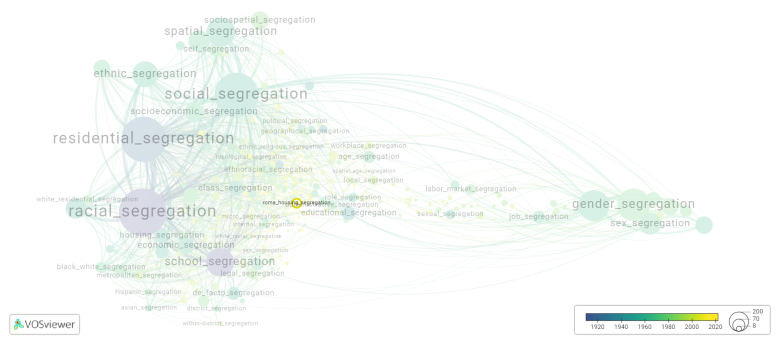Roma housing segregation: Difference between revisions
(Creating page) |
(Creating page) |
||
| (2 intermediate revisions by the same user not shown) | |||
| Line 24: | Line 24: | ||
[[File:roma_housing_segregation.png|780x780px]] | [[File:roma_housing_segregation.png|780x780px]] | ||
This visualization is based on the study [[Segregation_Wiki:About| The Multidisciplinary Landscape of Segregation Research]]. | |||
For the complete network of | For the complete network of interrelated segregation forms, please refer to: | ||
* [https://tinyurl.com/2235lkhw First year of publication] | |||
* [https://tinyurl.com/2d8wg5n3 Louvain clusters] | |||
* [https://tinyurl.com/223udk5r Betweenness centrality] | |||
* [https://tinyurl.com/244d8unz Disciplines in which segregation forms first emerged (Scopus database).] | |||
==References== | ==References== | ||
==Notes== | ==Notes== | ||
Latest revision as of 07:17, 16 October 2024
Date and country of first publication[1][edit | edit source]
2019
United Kingdom
Definition[edit | edit source]
Roma housing segregation refers to the practice of separating Roma communities from the general population and confining them to certain neighborhoods or settlements. This segregation is often the result of discrimination, prejudice, and social exclusion towards the Roma population.
Some common factors that contribute to Roma housing segregation include:
1. Discriminatory housing policies: Some governments have implemented policies that specifically target Roma communities, such as forcibly relocating them to segregated settlements or denying them access to housing in certain areas.
2. Social stigma and prejudice: Roma communities often face discrimination and prejudice from the general population, leading to their exclusion from mainstream society and the creation of segregated housing areas.
3. Economic inequality: Roma communities are often marginalized and economically disadvantaged, making it difficult for them to access affordable housing in desirable neighborhoods.
4. Lack of political representation: Roma populations are often underrepresented in political decision-making processes, leading to a lack of advocacy for their housing rights and needs.
Overall, Roma housing segregation perpetuates social inequality and reinforces the marginalization of Roma communities. Efforts to address this issue require a comprehensive approach that addresses not only housing access but also social inclusion, anti-discrimination policies, and community empowerment.
See also[edit | edit source]
Related segregation forms[edit | edit source]
Roma housing segregation is frequently discussed in the literature with the following segregation forms:
racial segregation, roma segregation

This visualization is based on the study The Multidisciplinary Landscape of Segregation Research.
For the complete network of interrelated segregation forms, please refer to:
References[edit | edit source]
Notes[edit | edit source]
- ↑ Date and country of first publication as informed by the Scopus database (December 2023).
At its current state, this definition has been generated by a Large Language Model (LLM) so far without review by an independent researcher or a member of the curating team of segregation experts that keep the Segregation Wiki online. While we strive for accuracy, we cannot guarantee its reliability, completeness and timeliness. Please use this content with caution and verify information as needed. Also, feel free to improve on the definition as you see fit, including the use of references and other informational resources. We value your input in enhancing the quality and accuracy of the definitions of segregation forms collectively offered in the Segregation Wiki ©.
Roma housing segregation appears in the following literature[edit | edit source]
Maestri G. (2019). Bringing the Third Sector Back into Ghetto Studies: Roma Segregation and Civil Society Associations in Italy. Class, Ethnicity and State in the Polarized Metropolis: Putting Wacquant to Work, 255-280. Springer International Publishing.https://doi.org/10.1007/9783030162221_11
